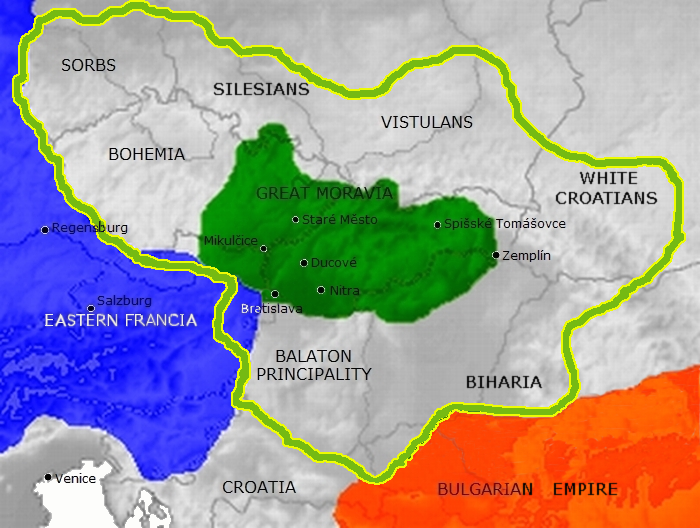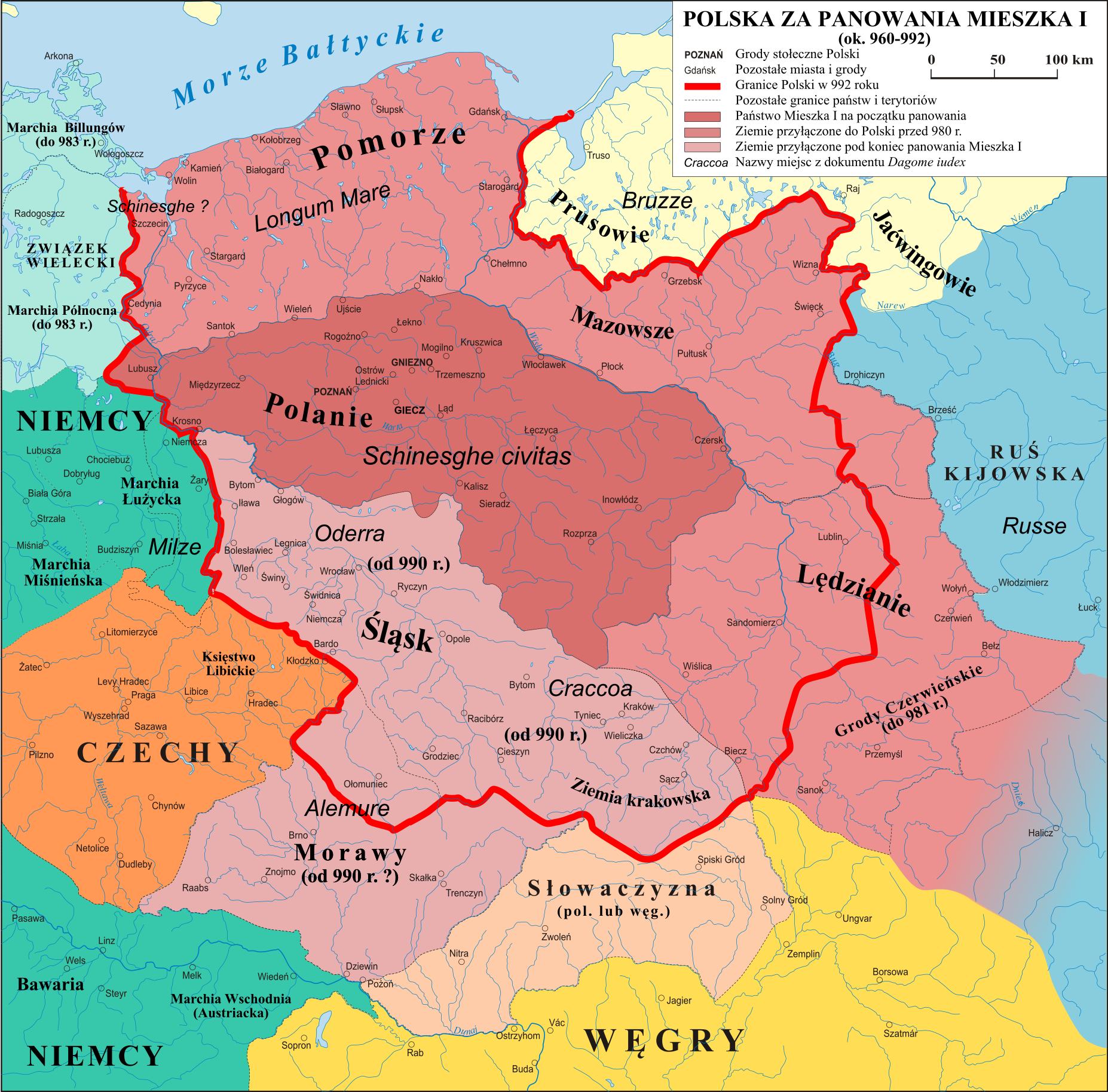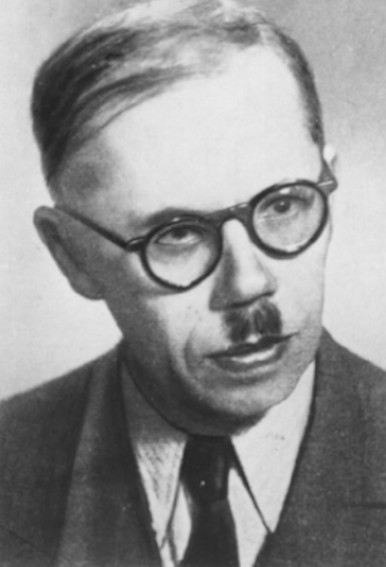|
Vistulans
The Vistulans, or Vistulanians ( pl, Wiślanie), were an early medieval Lechitic tribe inhabiting the western part of modern Lesser Poland."The main tribe inhabiting the reaches of the Upper Vistula and its tributaries was the Vislane (Wislanie) who, by the mid-ninth century were considered by the neighbouring Moravians as "very powerful" The expansionist policy of the Christian Moravian state led to eventual conflict with the pogan Vislane. ending in the defeat of the latter and their annexation to the Great Moravian Empire between Ad 875-879" . n:''Trade and urban development in Poland: an economic geography of Cracow''. Francis W. Carter. P. 46. 1994 op. cit. L. Hajdukiewicz and M. Karaś. ''The Jagiellonian University: Traditions, The Present, The Future''. Cracow. 1978, p. 17. Etymology Their name derives from the hydronym of the river Vistula, meaning "inhabitants of Vistula"; the region is mentioned as ''Uuislane'' by the Bavarian Geographer, ''v Vislè'' and ''v Vislèh'' ... [...More Info...] [...Related Items...] OR: [Wikipedia] [Google] [Baidu] |
White Croats
White Croats ( hr, Bijeli Hrvati; pl, Biali Chorwaci; cz, Bílí Chorvati; uk, Білі хорвати, Bili khorvaty), or simply known as Croats, were a group of Early Slavic tribes who lived among other West and East Slavic tribes in the area of modern-day Lesser Poland, Galicia (north of Carpathian Mountains), Western Ukraine, and Northeastern Bohemia. They were documented primarily by foreign medieval authors and managed to preserve their ethnic name until the early 20th century, primarily in Lesser Poland. It is considered that they were assimilated into Czech, Polish and Ukrainian ethnos, and are one of the predecessors of the Rusyn people. In the 7th century, some White Croats migrated from their homeland, Great White Croatia, to the territory of modern-day Croatia in Southeast Europe along the Adriatic Sea, forming the ancestors of the South Slavic ethnic group of Croats. Etymology It is generally believed that the Croatian ethnonym – ''Hrvat'', ''Horvat'' an ... [...More Info...] [...Related Items...] OR: [Wikipedia] [Google] [Baidu] |
Lesser Poland
Lesser Poland, often known by its Polish name Małopolska ( la, Polonia Minor), is a historical region situated in southern and south-eastern Poland. Its capital and largest city is Kraków. Throughout centuries, Lesser Poland developed a separate culture featuring diverse architecture, folk costumes, dances, cuisine, traditions and a rare Lesser Polish dialect. The region is rich in historical landmarks, monuments, castles, natural scenery and UNESCO World Heritage Sites. The region should not be confused with the modern Lesser Poland Voivodeship, which covers only the southwestern part of Lesser Poland. Historical Lesser Poland was much larger than the current voivodeship that bears its name. It reached from Bielsko-Biała in the southwest as far as to Siedlce in the northeast. It consisted of the three voivodeships of Kraków, Sandomierz and Lublin. It comprised almost 60,000 km2 in area; today's population in this area is about 9,000,000 inhabitants. Its land ... [...More Info...] [...Related Items...] OR: [Wikipedia] [Google] [Baidu] |
Lendians
The Lendians ( pl, Lędzianie) were a Lechitic tribe who lived in the area of East Lesser Poland and Cherven Cities between the 7th and 11th centuries. Since they were documented primarily by foreign authors whose knowledge of Central and East Europe geography was often vague, they were recorded by different names, which include ''Lendzanenoi'', ''Lendzaninoi'', ''Lz’njn'', ''Lachy'', ''Lyakhs'', ''Landzaneh'', ''Lendizi'', ''Licicaviki'' and ''Litziki''. Name The name "Lędzianie" (*lęd-jan-inъ) derives from the Proto-Slavic and Old Polish word "lęda", meaning "field". In modern Polish, the word "ląd" means "land". The Lędzianie tribe's name comes from their use of slash-and-burn agriculture, which involved cutting and burning of forests or woodlands to create fields. Accordingly, in this meaning Lendians were woodland-burning farmers, or "inhabitants of fields". Several European nations source their ethnonym for Poles, and hence Poland, from the name of Lendians: Lit ... [...More Info...] [...Related Items...] OR: [Wikipedia] [Google] [Baidu] |
Lechites
Lechites (, german: Lechiten), also known as the Lechitic tribes (, german: Lechitische Stämme), is a name given to certain West Slavic tribes who inhabited modern-day Poland and eastern Germany, and were speakers of the Lechitic languages. Distinct from the Czech–Slovak subgroup, they are the closest ancestors of ethnic Poles and the Pomeranians, Lusatians and Polabians. History According to Polish legend, Mieszko I inherited the ducal throne from his father who probably ruled over two-thirds of the territory inhabited by eastern Lechite tribes. He united the Lechites east of the Oder ( Polans, Masovians, Pomeranians, Vistulans, Silesians) into a single country of Poland. His son, Bolesław I the Brave, founded the bishoprics at Wrocław, Kołobrzeg, and Kraków, and an archbishopric at Gniezno. Bolesław carried out successful wars against Bohemia, Moravia, Kievan Rus' and Lusatia, and forced the western Pomeranians to pay Poland a tribute. Shortly before his death ... [...More Info...] [...Related Items...] OR: [Wikipedia] [Google] [Baidu] |
Vistula
The Vistula (; pl, Wisła, ) is the longest river in Poland and the ninth-longest river in Europe, at in length. The drainage basin, reaching into three other nations, covers , of which is in Poland. The Vistula rises at Barania Góra in the south of Poland, above sea level in the Silesian Beskids (western part of Carpathian Mountains), where it begins with the Little White Vistula (''Biała Wisełka'') and the Black Little Vistula (''Czarna Wisełka''). It flows through Poland's largest cities, including Kraków, Sandomierz, Warsaw, Płock, Włocławek, Toruń, Bydgoszcz, Świecie, Grudziądz, Tczew and Gdańsk. It empties into the Vistula Lagoon (''Zalew Wiślany'') or directly into the Gdańsk Bay of the Baltic Sea with a delta of six main branches (Leniwka, Przekop, Śmiała Wisła, Martwa Wisła, Nogat and Szkarpawa). The river is often associated with Polish culture, history and national identity. It is the country's most important waterway and natural sy ... [...More Info...] [...Related Items...] OR: [Wikipedia] [Google] [Baidu] |
Bavarian Geographer
The epithet "Bavarian Geographer" ( la, Geographus Bavarus) is the conventional name for the anonymous author of a short Latin medieval text containing a list of the tribes in Central- Eastern Europe, headed (). The name "Bavarian Geographer" was first bestowed (in its French form, "") in 1796 by Polish count and scholar Jan Potocki. The term is now also used at times to refer to the document itself. It was the first Latin source to claim that all Slavs have originated from the same homeland, called the Zeriuani. Origin and content The short document, written in Latin, was discovered in 1772 in the Bavarian State Library, Munich by Louis XV's ambassador to the Saxon court, Comte Louis-Gabriel Du Buat-Nançay. It had been acquired by the Wittelsbachs with the collection of the antiquarian Hermann Schädel (1410–85) in 1571. The document was much discussed in the early 19th-century historiography, notably by Nikolai Karamzin and Joachim Lelewel. The provenance of the doc ... [...More Info...] [...Related Items...] OR: [Wikipedia] [Google] [Baidu] |
Lubor Niederle
Lubor Niederle (September 20, 1865 – June 14, 1944) was a Czech archeologist, anthropologist and ethnographer. He is seen as one of the founders of modern archeology in Czech lands. He was born in Klatovy. He studied at the Charles University in Prague from 1883 to 1887. He was initially interested in classical archaeology, then studied anthropology, sociology and ethnology. Later, he studied in Munich under professor Johannes Rank (1889) and in Paris under professor Léonce Manouvriere at the École d’anthropologie. Niederle also travelled in several Slavic countries, studying archaeological findings and historical documents. In 1898 Niederle was named professor at the Charles University. As archaeologist he had represented the "university school" (''univerzitní škola''), opposed to the "museum school" (''muzejní škola'') represented by archaeologist Josef Ladislav Píč. During 1907–08 Niederle served as a dean of Faculty of Philosophy, during 1908–09 as a vice-d ... [...More Info...] [...Related Items...] OR: [Wikipedia] [Google] [Baidu] |
Henryk Łowmiański
Henryk Łowmiański (August 22, 1898 near Ukmergė - September 4, 1984 in Poznań) was a Polish historian and academic who was an authority on the early history of the Slavic and Baltic people. A researcher of the ancient history of Poland, Lithuania and the Slavs in general, Łowmiański was the author of many works, including most prominently the six-volume monumental monograph '' Początki Polski'' (''The Beginnings of Poland''). Scholar years Łowmiański was born to father Konstanty and mother Kazimiera ''née'' Rudzińska. After receiving his doctorate on the ''"Wschody" miast litewskich w XVI wieku'' (''Beginnings of Lithuanian Cities'') in 1924, Łowmiański became the first history Ph.D in the University of Stefan Batory (USB). Prior the World War II, working as an academic archivist wrote a two-volume ''Studia nad początkami społeczeństwa i państwa litewskiego'' (1931-32), and a treatise ''Uwagi w sprawie podłoża społec-znego i gospodarczego Unii Jagiellońskiej' ... [...More Info...] [...Related Items...] OR: [Wikipedia] [Google] [Baidu] |
Leontii Voitovych
Leontii Voitovych ( ua, Войтович Леонтій Вікторович, May 16, 1951, Yemanzhelinsk, Chelyabinsk Oblast now Russian Federation) is a modern Ukrainian scientist-historian and holds a Doctor of Science (Ukrainian: До́ктор нау́к) degree. He is a research fellow of the department of Middle Ages history at the Krypiakevych Institute of Ukrainian Studies (National Academy of Sciences of Ukraine) as well as an academic department director of history of Middle Ages and Byzantine studies in the University of Lviv. Biography Born in the Ural region of the Russian Federation, Voitovych is from the Western Ukraine. A brother of his grandfather, Petro Voitovych (1862–1938), was a Lviv sculptor and known for his works of Lviv Opera. His family was deported across the Ural Mountains during the Stalin period and he was growing up in small mining town with many other children of Soviet exiles. His father, who finished the Prague Polytechnic as a bridge engi ... [...More Info...] [...Related Items...] OR: [Wikipedia] [Google] [Baidu] |
Central Europe 9th Century
Central is an adjective usually referring to being in the center of some place or (mathematical) object. Central may also refer to: Directions and generalised locations * Central Africa, a region in the centre of Africa continent, also known as Middle Africa * Central America, a region in the centre of America continent * Central Asia, a region in the centre of Eurasian continent * Central Australia, a region of the Australian continent * Central Belt, an area in the centre of Scotland * Central Europe, a region of the European continent * Central London, the centre of London * Central Region (other) * Central United States, a region of the United States of America Specific locations Countries * Central African Republic, a country in Africa States and provinces * Blue Nile (state) or Central, a state in Sudan * Central Department, Paraguay * Central Province (Kenya) * Central Province (Papua New Guinea) * Central Province (Solomon Islands) * Central Province, Sri Lank ... [...More Info...] [...Related Items...] OR: [Wikipedia] [Google] [Baidu] |
Tadeusz Lehr-Spławiński
Tadeusz Lehr-Spławiński (September 20, 1891 – February 17, 1965) was a Polish linguist, scholar, and professor of Slavonic studies. He was twice elected rector of the Jagiellonian University in Kraków before and after the Nazi German occupation of Poland. Biography Lehr-Spławiński was born in Kraków, the son of Edward Lehr, an engineer, and Maria '' née'' Spławińska. He went to Jan III Sobieski high school and, in the years 1909–1915 studied linguistics, history of Polish literature as well as classical philology, at the Jagiellonian University in Kraków. He continued his studies in Vienna, and began his teaching career in Zakopane. In 1918 (following Poland's return to independence), Lehr-Spławiński became professor at Poznań University and, from 1922, the University of Lwów, at both of which he led the Department of Slavonic Philology. From 1929 until his retirement in 1962, he was professor of linguistics at Jagiellonian University, elected as its Rector for ... [...More Info...] [...Related Items...] OR: [Wikipedia] [Google] [Baidu] |
Lombards
The Lombards () or Langobards ( la, Langobardi) were a Germanic people who ruled most of the Italian Peninsula from 568 to 774. The medieval Lombard historian Paul the Deacon wrote in the '' History of the Lombards'' (written between 787 and 796) that the Lombards descended from a small tribe called the Winnili,: "From Proto-Germanic '' winna-'', meaning "to fight, win" who dwelt in southern Scandinavia (''Scadanan'') before migrating to seek new lands. By the time of the Roman-era - historians wrote of the Lombards in the 1st century AD, as being one of the Suebian peoples, in what is now northern Germany, near the Elbe river. They continued to migrate south. By the end of the fifth century, the Lombards had moved into the area roughly coinciding with modern Austria and Slovakia north of the Danube, where they subdued the Heruls and later fought frequent wars with the Gepids. The Lombard king Audoin defeated the Gepid leader Thurisind in 551 or 552, and his successor A ... [...More Info...] [...Related Items...] OR: [Wikipedia] [Google] [Baidu] |






